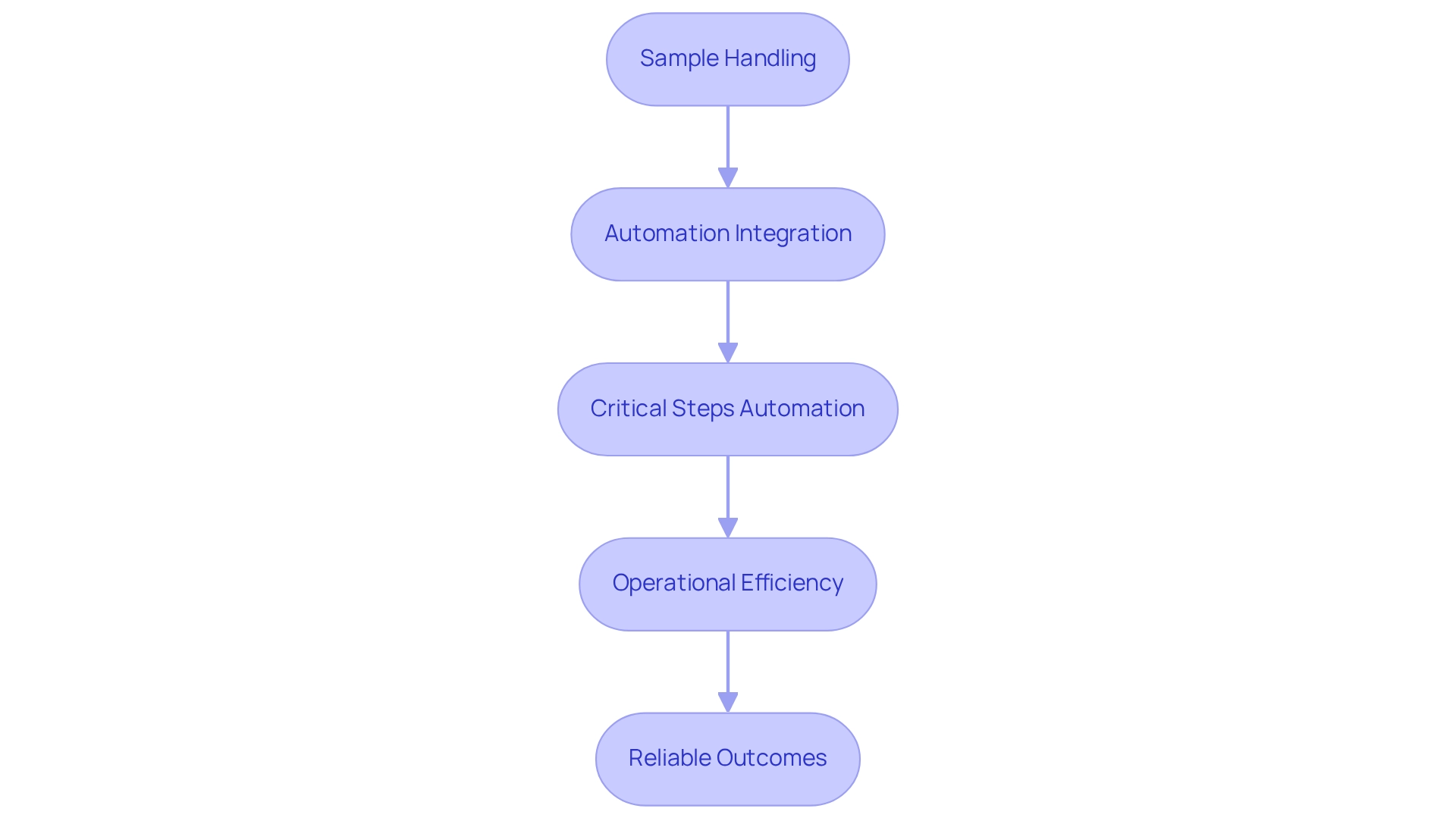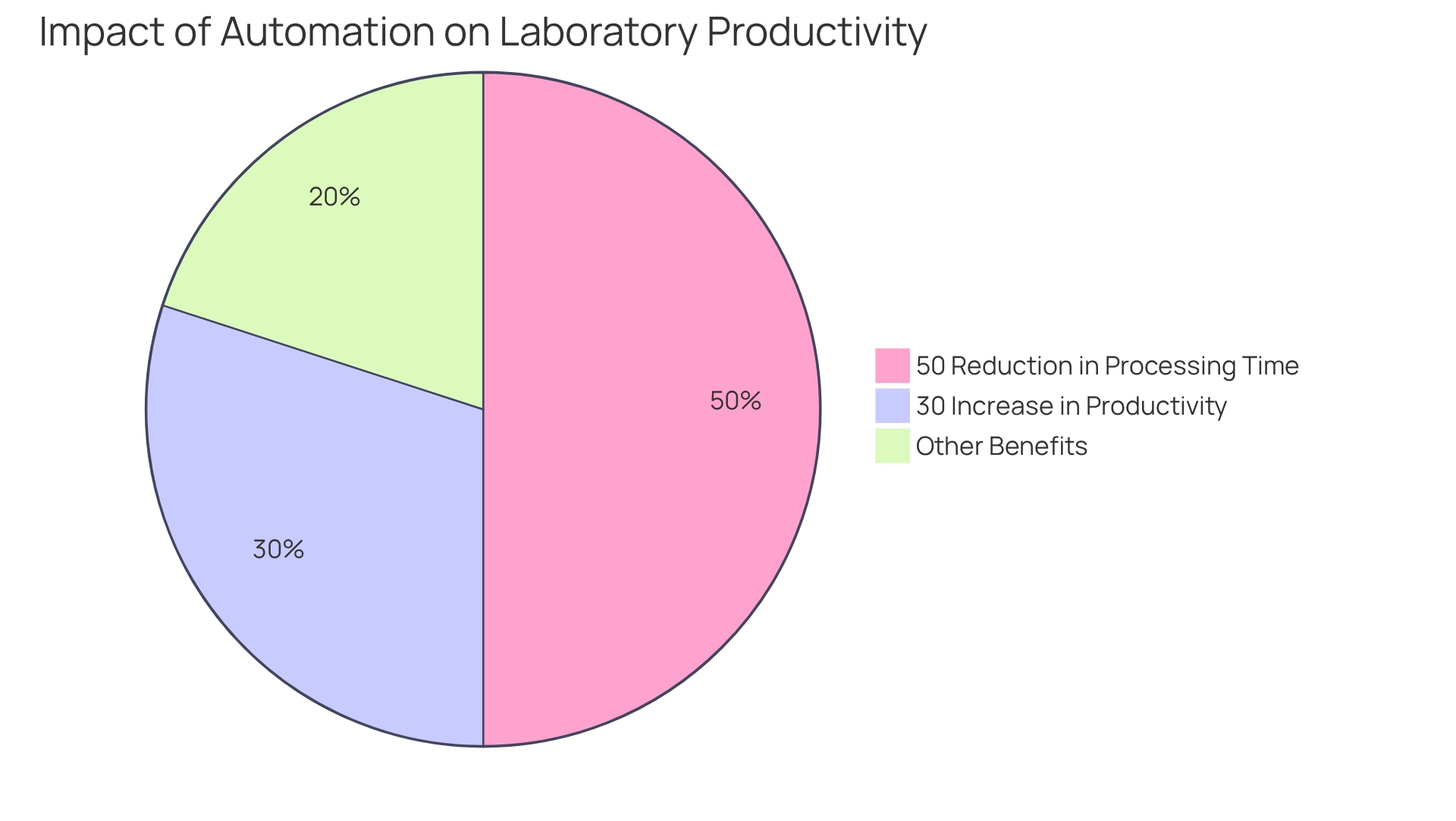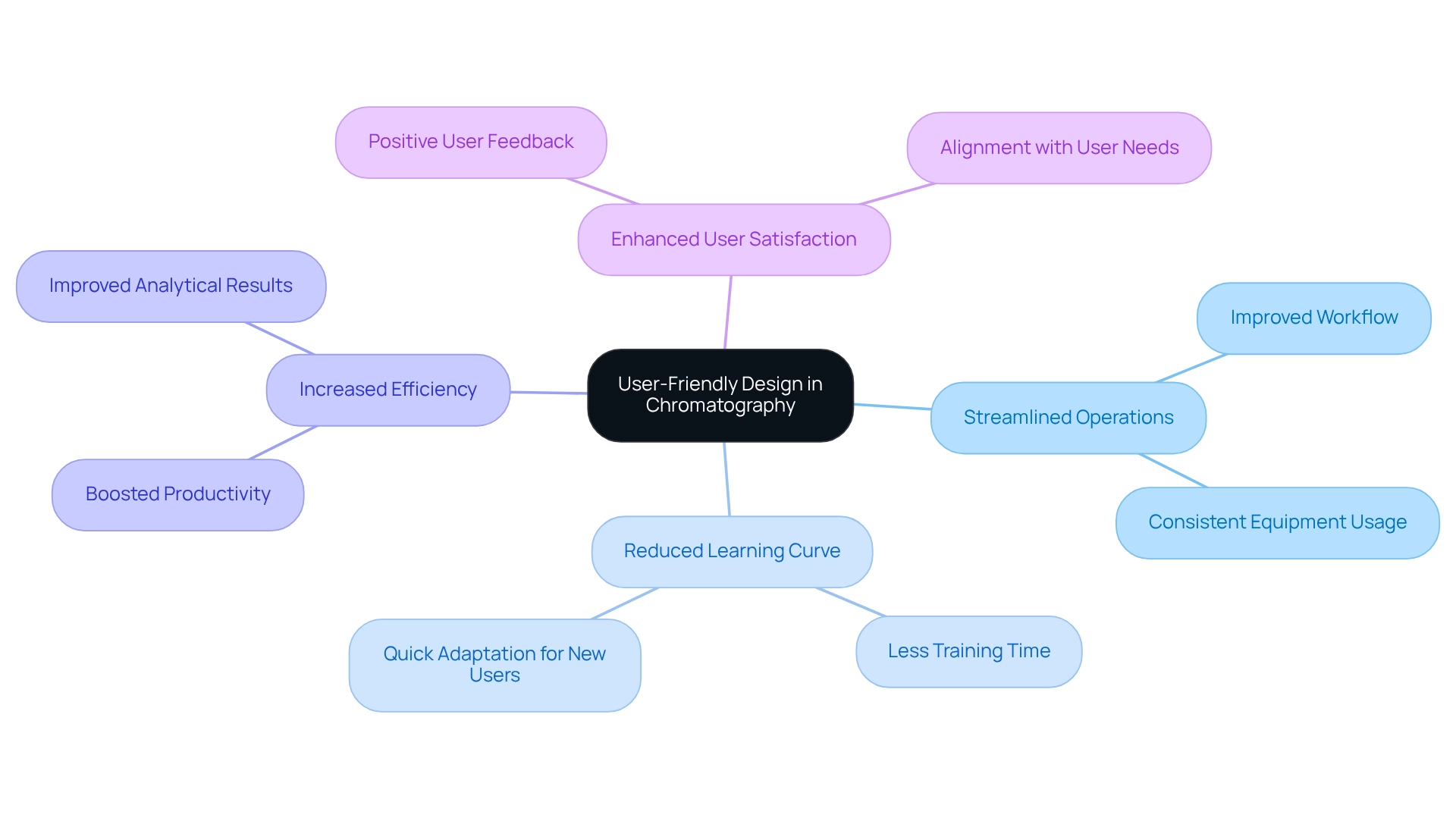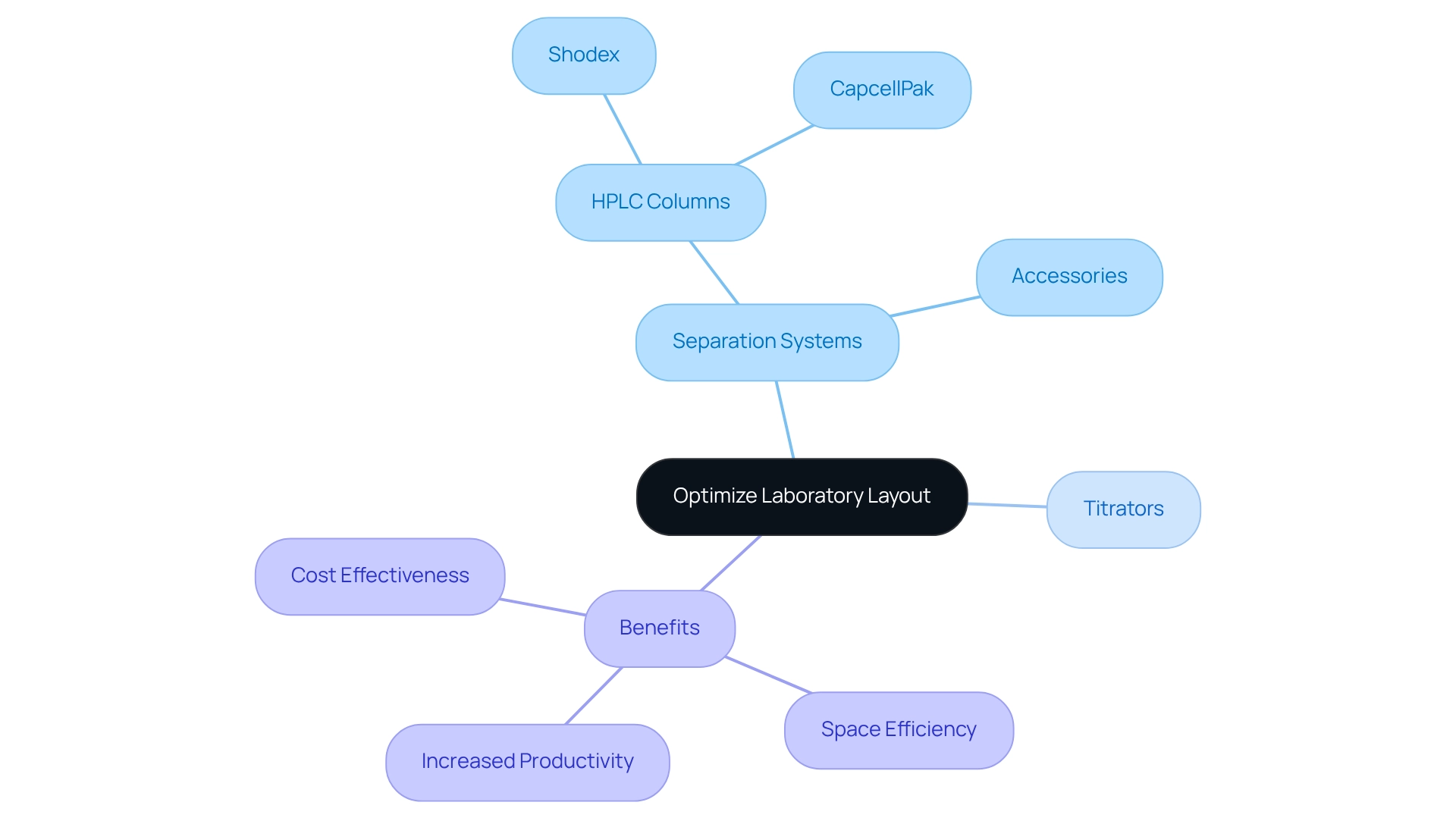Overview
The article delineates ten key benefits of employing chromatography skids in laboratory environments, highlighting their critical role in enhancing workflow efficiency, reducing operational costs, and improving result quality. By detailing the advantages of automation, it illustrates how these systems minimize manual intervention, optimize purification processes, and offer versatile applications. This ultimately leads to more reliable and consistent analytical outcomes across various laboratory settings, reinforcing the necessity of high-quality scientific instruments in modern research.
Introduction
In the rapidly advancing realm of laboratory technology, JM Science's chromatography skids emerge as a pivotal innovation, meticulously engineered to enhance efficiency and precision in sample processing.
As laboratories face mounting pressures for accuracy and speed, these sophisticated systems present a solution that significantly reduces manual intervention while optimizing operational workflows.
By automating essential steps in chromatography, these skids not only streamline processes but also markedly diminish the potential for human error, yielding more dependable results.
With an emphasis on versatility, cost-effectiveness, and intuitive design, JM Science's chromatography skids are set to revolutionize laboratory practices, accommodating a broad spectrum of applications while delivering consistent, high-quality outcomes.
JM Science Chromatography Skids: Streamlined Workflow and Efficiency
JM Science's separation systems are expertly crafted to integrate seamlessly into research workflows, significantly minimizing the time and effort required for sample handling. By automating critical steps in the chromatography process, these systems reduce manual intervention, allowing staff to concentrate on more essential tasks. This streamlined approach not only enhances operational efficiency but also mitigates the risk of human error, resulting in more reliable and reproducible outcomes.
Recent advancements in automation have shown that facilities employing automated systems can achieve workflow efficiency improvements of up to 30%. The Freedom EVO platform, specifically engineered for sample preparation, performs tasks such as protein precipitation and solid phase extraction, showcasing how automation can revolutionize sample preparation protocols. A compelling case study from the Reinier de Graaf Hospital in the Netherlands illustrates this impact; the implementation of the Freedom EVO workstation fully automated vitamin testing workflows, significantly enhancing throughput and quality control while lowering labor costs.
Laboratory managers have reported that utilizing a chromatography skid accelerates processes and improves result accuracy. As Frans noted, "If we can achieve that, then we will have a Freedom EVO platform encompassing the complete sample preparation spectrum which, to me, seems to be a significant paradigm shift for medical facilities." By reducing manual handling of samples, these systems foster a more consistent and reliable analytical environment. Moreover, ongoing advancements in liquid-liquid extraction protocols for the Freedom EVO platform underscore the continuous improvement and capabilities of these automation systems. As the demand for efficient and precise operations in research facilities continues to rise, the integration of separation systems represents a pivotal advancement in automation, aligning with the evolving needs of the scientific community.

Scalable Chromatography Skids: Adapt to Varying Flow Rates
The chromatography skid from JM Science is meticulously designed to accommodate a diverse range of flow rates, making it ideal for applications spanning from small-scale research to large-scale production. This versatility enables laboratories to effectively process different sample types without requiring significant equipment alterations, ultimately saving both time and resources.
Recent advancements in single-use separation systems have further improved this adaptability, allowing compatibility with various purification technologies, including membrane separation and monolithic columns. A case study titled 'Compatibility of Single-Use Systems with Purification Technologies' emphasizes how these systems facilitate high-throughput applications and continuous separation processes, demonstrating their effectiveness in biopharmaceutical manufacturing.
Statistics indicate that single-use systems significantly reduce contamination risks and streamline cleaning processes, leading to faster turnaround times. Moreover, the automation features of these systems minimize human errors during processing, enhancing overall safety and efficiency. As Sbardella observes, the main advantages of single-use separation systems encompass improved safety, decreased chances of human mistakes thanks to automation, and streamlined validation procedures for increased confidence in regulatory adherence. As the sector develops, the capacity to adjust flow rates in separation systems becomes progressively essential, enabling facilities to address diverse requirements without sacrificing performance.
Expert insights emphasize that the adaptability and scalability of separation systems not only enhance productivity but also streamline validation processes, ensuring adherence to regulatory standards. This flexibility is crucial for facilities seeking to enhance their workflows by integrating a chromatography skid while ensuring high-quality outcomes across various applications. Furthermore, with the White House instructing the FDA to lessen regulatory obstacles for domestic pharmaceutical production, the importance of flexible separation systems in the current environment is underscored.
Cost-Effective Solutions: Reduce Operational Expenses with Chromatography Skids
Investing in separation systems offers laboratories substantial cost reductions by optimizing processes and minimizing manual labor. These advanced systems are engineered to enhance efficiency, resulting in decreased operational expenses. For instance, the implementation of multicolumn continuous separation platforms has been shown to reduce buffer consumption by 40–45%, which significantly lowers overall costs. Jukka Kervinen, manager of the applications group, asserts, "Using MCC helps reduce overall protein A requirements of ≤90% and reduce buffer consumption of 40–45%."
Additionally, a case study on monoclonal antibody purification revealed that employing MCC technology achieved an impressive yield of 87%, while delivering several-fold greater productivity compared to traditional methods. This not only underscores the effectiveness of chromatography skid systems but also highlights their potential to enhance return on investment. By optimizing resource utilization and minimizing waste, research facilities can realize improved financial performance through the adoption of these innovative solutions.
Improved Purification Processes: Achieve Higher Quality Results
The chromatography skid techniques significantly enhance purification processes by providing precise control over critical parameters, including flow rates and gradient profiles. This meticulous control optimizes the separation of compounds, leading to elevated purity levels and improved overall quality of the final product. Recent advancements in automated separation systems have demonstrated substantial enhancements in purity, with some laboratories reporting purity levels exceeding 99% in their final outputs. Such high-quality results are essential for compliance with stringent regulatory standards. Moreover, expert insights underscore the importance of the chromatography skid in refining purification processes. A senior scientist noted that cation exchange separation can effectively diminish antibody variants, ensuring that the target antibody product remains consistent and of high quality. This capability is particularly crucial in the pharmaceutical sector, where the quality of monoclonal antibody products is paramount.
Case studies further illustrate the advantages of advanced purification systems, particularly those utilizing a chromatography skid. One study focused on the challenges of scaling up purification processes from research to manufacturing scale, emphasizing the necessity for careful optimization to maintain efficiency and product quality. The findings revealed that facilities employing advanced separation systems faced fewer issues during this transition, resulting in more reliable outcomes.
In conclusion, integrating separation systems into operational workflows not only streamlines purification procedures but also guarantees superior quality results, establishing them as indispensable resources for facilities aiming to meet the evolving demands of the scientific community. To fully leverage the benefits of these systems, facilities should consider regular training for personnel on the latest methods and technologies, ensuring they are well-equipped to utilize these advanced setups efficiently.

Automated Chromatography Skids: Boost Laboratory Productivity
The automation features of JM Science's chromatography skid play a pivotal role in enhancing laboratory productivity. By streamlining essential tasks such as sample loading, buffer preparation, and data collection, these systems significantly alleviate the workload on staff. This automation not only frees up valuable time but also enables facilities to manage a greater volume of samples in a shorter timeframe, thereby accelerating both research and production timelines.
Notably, statistics indicate that laboratories employing automated separation solutions have experienced productivity increases of up to 30%. Furthermore, expert insights reveal that automation in separation techniques can lead to reductions in sample processing times by as much as 50%, facilitating quicker turnaround for critical analyses.
Laboratory supervisors have reported substantial time savings, with many asserting that the integration of separation units has transformed their operational efficiency. As we approach 2025, the momentum towards automation in research facilities is expected to continue, with numerous institutions significantly enhancing their sample throughput.
Case studies illustrate that facilities utilizing a chromatography skid for automated separation systems have not only streamlined their workflows but have also bolstered the accuracy and reliability of their results, positioning themselves at the forefront of scientific advancement.

User-Friendly Design: Simplify Laboratory Operations
JM Science's chromatography skid systems are meticulously engineered with a user-friendly design that significantly streamlines laboratory operations. The intuitive interfaces and straightforward setup processes effectively reduce the learning curve for new users, ensuring that even those unfamiliar with the technology can quickly adapt. This simplicity not only boosts operational efficiency but also promotes consistent equipment usage, ultimately leading to improved analytical results.
Laboratories employing these platforms report a notable reduction in training time, which enhances productivity and user satisfaction. User feedback consistently emphasizes the ease of use, reinforcing the importance of investing in a chromatography skid that is well-designed to meet actual user requirements.
Furthermore, JM Science Inc. provides an extensive selection of HPLC columns and accessories, which enhance the systems and improve their functionality.

Reliable Performance: Ensure Consistency in Results
Dependability serves as the cornerstone of JM Science's separation systems, meticulously engineered to provide consistent performance across a myriad of applications. These systems are indispensable in ensuring that laboratories can trust their findings, a necessity for maintaining the integrity of scientific research and production. By significantly minimizing variability in the separation process, the chromatography skids not only bolster regulatory compliance but also elevate the overall quality of analytical outcomes. As we approach 2025, the emphasis on stable results in analytical separation techniques has never been more critical. Recent advancements in automated systems have led to a notable reduction in variability, thereby enhancing the reliability metrics associated with analytical equipment performance. Robustness testing during method development has illustrated that analytical methods can remain unaffected by minor fluctuations in parameters, thereby ensuring consistent outcomes across diverse conditions.
Expert insights underscore the paramount importance of reliability in analytical techniques. Quality assurance professionals consistently assert that a reputable brand is built on the foundation of delivering trustworthy results. This sentiment is echoed in case studies that showcase the effectiveness of equipment within research environments, where reliable performance correlates with improved research outcomes and compliance with industry standards.
Furthermore, normal-phase separation techniques have proven to be invaluable for isolating sensitive substances, thereby bolstering pharmaceutical research and environmental monitoring efforts. As research facilities continue to prioritize precision, the dependability of JM Science's equipment stands out as a crucial asset in achieving consistent and accurate analytical results.
Space-Saving Solutions: Optimize Laboratory Layout
The compact structure of JM Science's separation systems empowers facilities to optimize their layout efficiently. By minimizing the footprint of separation equipment—including our premium HPLC columns such as Shodex and CapcellPak, along with essential accessories—these platforms enable laboratories to make the most of their available space. This advantage is particularly significant for smaller facilities or those facing spatial constraints, fostering a more organized and effective working environment.
Furthermore, our innovative titrators and other scientific instruments enhance this space-saving strategy, allowing labs to sustain high productivity without sacrificing quality. The competitive pricing of our products further amplifies their value for pharmaceutical lab managers, ensuring that they can achieve excellence in their operations.

Versatile Applications: Cater to Diverse Laboratory Needs
JM Science's chromatography skid exemplifies versatility, making it ideal for a diverse array of laboratory applications. These supports prove particularly effective in biopharmaceutical production, facilitating the purification of monoclonal antibodies (mAbs) through optimized elution conditions, such as linear gradient elution from 5 mM to 250 mM NaCl at pH 6. The anticipated growth in the environmental testing sector, driven by an increasing demand for accurate pollutant assessment in air, water, and soil, underscores the equipment's capacity to adapt to stringent testing standards.
The adaptability of these platforms, such as the chromatography skid, empowers laboratories to efficiently manage a variety of projects without the need for multiple specialized systems. This flexibility is vital for academic research, where diverse experimental setups frequently necessitate customized solutions. Case studies indicate that while this technique excels in analytical chemistry, it also encounters challenges, such as elevated costs and intricate sample preparation. These factors can impact the efficiency of separation systems; however, awareness of these limitations allows researchers to refine their techniques, ensuring reliable outcomes while fully leveraging the separation process's capabilities.
Expert insights highlight the adaptability of separation techniques. For instance, Robert Bayer, a Senior Scientist, asserts that "the dynamic binding capacity of mAbs on cation exchange resins depends on pH and conductivity." This perspective further illustrates the importance of selecting the appropriate chromatography skid for specific research needs, reinforcing JM Science's commitment to providing high-quality, flexible solutions for the scientific community.
Comprehensive Support: Access Resources for Optimal Use
JM Science provides comprehensive support for its separation systems, ensuring users have access to essential resources for optimal performance. This includes:
- In-depth user manuals
- Troubleshooting guides
- Dedicated customer service assistance
By offering these critical resources, JM Science empowers laboratories to enhance the efficiency of their chromatography skid, ultimately leading to improved results and increased productivity. Such support is not merely beneficial; it is essential for laboratories striving for excellence in their operations.
Conclusion
The integration of JM Science's chromatography skids into laboratory workflows serves as a transformative solution that significantly enhances efficiency, accuracy, and reliability in sample processing. By automating critical steps and minimizing manual intervention, these systems streamline operations, allowing laboratory personnel to concentrate on more essential tasks while substantially reducing the risk of human error. Furthermore, the adaptability of these skids to various flow rates underscores their versatility, enabling laboratories to efficiently manage diverse applications without the necessity for extensive modifications.
Cost-effectiveness stands out as another considerable advantage, as the implementation of chromatography skids can yield substantial operational savings through optimized resource utilization and reduced waste. Their capacity to enhance purification processes ensures higher quality results, which are crucial for compliance with regulatory standards. Additionally, the user-friendly design of these skids simplifies laboratory operations, thereby reducing training time and boosting productivity.
As laboratories increasingly prioritize automation and reliability, JM Science's chromatography skids emerge as essential assets in achieving consistent and accurate analytical results. With comprehensive support resources readily available, laboratories are well-positioned to leverage these advanced systems to meet the evolving demands of the scientific community. Ultimately, the adoption of chromatography skids signifies a pivotal advancement that aligns seamlessly with the growing need for precision and efficiency in laboratory practices.




